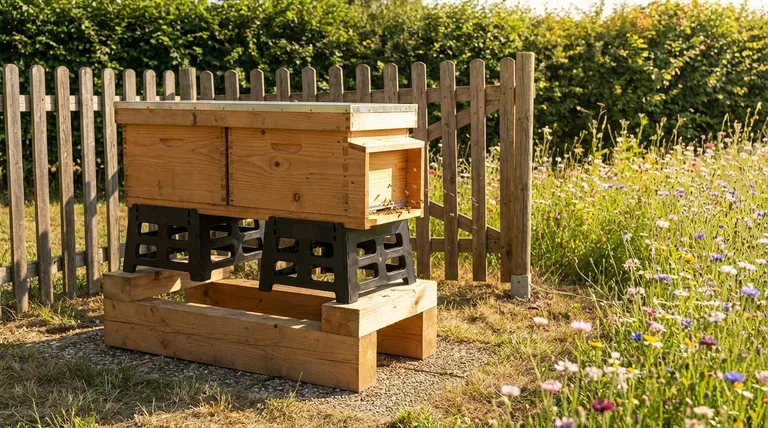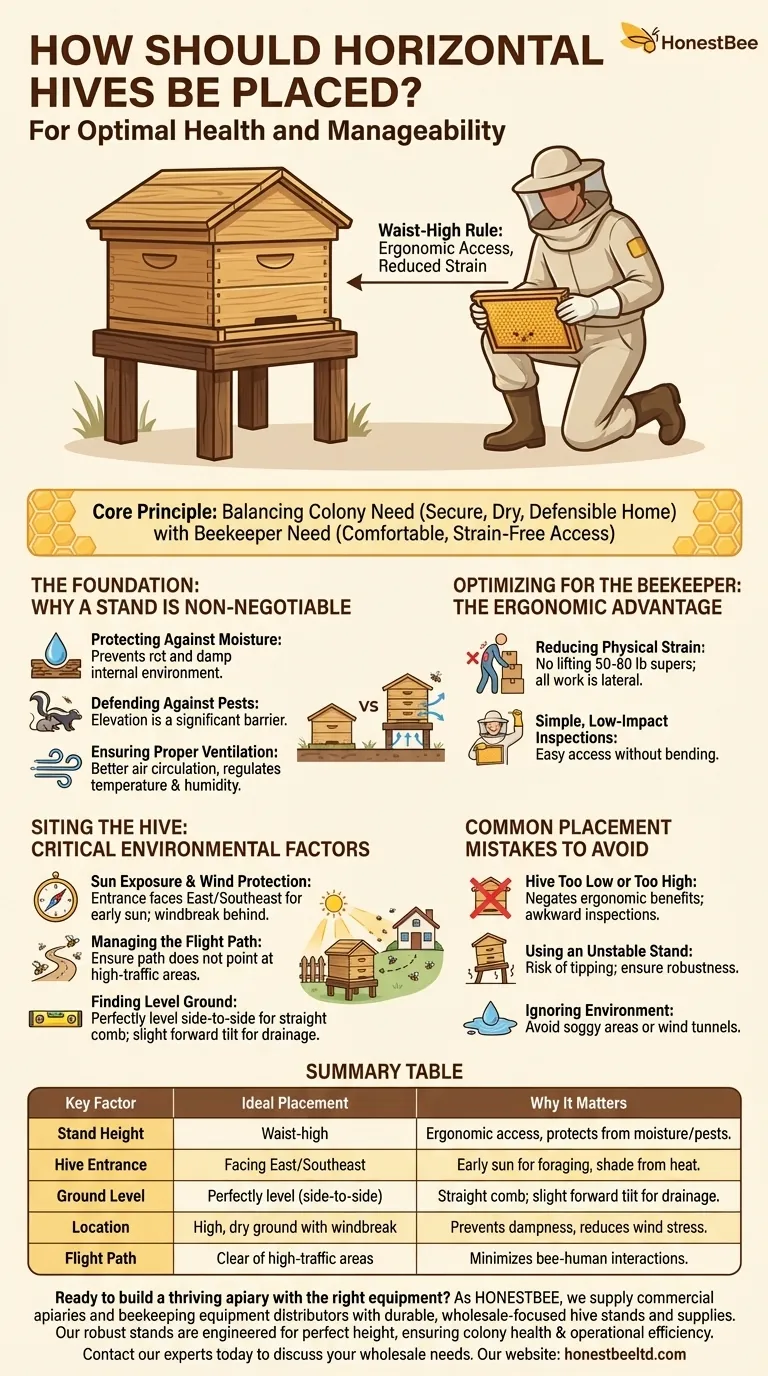For optimal health and manageability, a horizontal hive must be placed on a sturdy stand that positions it roughly waist-high. This elevation is critical for protecting the colony from ground-level threats like moisture and pests while providing the beekeeper with ergonomic access for inspections and honey harvesting.
The core principle of horizontal hive placement is a balance between two needs: the colony's need for a secure, dry, and defensible home, and the beekeeper's need for comfortable, strain-free access to the frames.

The Foundation: Why a Stand is Non-Negotiable
Placing a hive directly on the ground is one of the most common and damaging mistakes a new beekeeper can make. A dedicated stand is not optional; it is a fundamental piece of equipment.
Protecting Against Moisture
Wood in direct contact with the ground will inevitably absorb moisture. This leads to rot, compromises the hive's structural integrity, and creates a damp internal environment that is unhealthy for bees and promotes mold growth.
Defending Against Pests
Elevation is your first line of defense. A hive sitting on the ground is an open invitation for pests like mice, skunks, and other small animals that can disturb or destroy a colony. A stand creates a significant barrier to entry.
Ensuring Proper Ventilation
Lifting the hive off the ground allows for better air circulation around and underneath it. This helps regulate temperature and humidity, reducing stress on the colony as they work to maintain a stable internal environment.
Optimizing for the Beekeeper: The Ergonomic Advantage
One of the primary benefits of a horizontal hive is its ease of use compared to stacking and lifting heavy boxes. Proper placement is key to realizing this advantage.
The "Waist-High" Rule
Positioning the hive so the top bars are at or near your waist is the ideal height. This allows you to lift frames straight up and out for inspection without bending over or straining your back.
Reducing Physical Strain
Unlike vertical hives that require lifting 50-80 lb supers, a horizontal hive's work is all lateral. By setting the height correctly from the start, you make every future inspection a simple, low-impact task.
Siting the Hive: Critical Environmental Factors
Beyond the stand itself, the hive's location on your property has a major impact on the colony's success and your safety.
Sun Exposure and Wind Protection
Ideally, the hive entrance should face east or southeast. This allows the bees to get early morning sun, encouraging them to start foraging sooner, while offering some shade from the intense late-afternoon heat. A windbreak, such as a hedge or fence, behind the hive also helps the colony conserve energy.
Managing the Flight Path
Observe the area directly in front of the hive entrance. This is the bees' primary flight path. Ensure it does not point directly at a patio, doorway, or high-traffic walkway to minimize unwanted interactions between bees and people.
Finding Level Ground
Your hive must be perfectly level from side-to-side. This ensures the bees build straight, even comb within the frames. A slight forward tilt (about half an inch) can help rainwater run off the landing board and out of the hive.
Common Placement Mistakes to Avoid
Proper setup prevents future problems. Be mindful of these common errors that can undermine an otherwise healthy hive.
Placing the Hive Too Low or Too High
A hive that is too low negates the ergonomic benefits and requires you to hunch over. A hive that is too high can make inspections awkward and difficult, especially for shorter individuals. Find the height that is right for your body.
Using an Unstable Stand
A wobbly or insecure stand is a major risk. A hive full of bees, brood, and honey is extremely heavy. Ensure your stand is robust, level, and can easily support several hundred pounds without tipping.
Ignoring the Surrounding Environment
Do not place your hive in a soggy, low-lying area or in a wind tunnel. Pay attention to how sun, wind, and water move across your property and choose a location that gives the bees the best possible advantage.
Making the Right Choice for Your Location
Selecting the final spot is a permanent decision for the season. Consider your priorities to find the perfect balance.
- If your primary focus is ease of management: Measure the height from the ground to your waist and build or buy a stand that places the hive's top bars precisely at that level.
- If your primary focus is colony health: Prioritize a location with morning sun, afternoon shade, and protection from prevailing winds, ensuring it is on high, dry ground.
- If your primary focus is safety and harmony: Orient the hive entrance away from any paths, patios, or play areas to create a dedicated, low-traffic zone for the bees.
Thoughtful placement is your first step in a successful partnership with your bees.
Summary Table:
| Key Factor | Ideal Placement | Why It Matters |
|---|---|---|
| Stand Height | Waist-high | Ergonomic access for inspections, protects from ground moisture and pests. |
| Hive Entrance | Facing East/Southeast | Early morning sun for foraging, shade from afternoon heat. |
| Ground Level | Perfectly level (side-to-side) | Ensures bees build straight comb. Slight forward tilt for drainage. |
| Location | High, dry ground with windbreak | Prevents dampness, reduces colony stress from wind. |
| Flight Path | Clear of high-traffic areas | Minimizes bee-human interactions for safety. |
Ready to build a thriving apiary with the right equipment? As HONESTBEE, we supply commercial apiaries and beekeeping equipment distributors with durable, wholesale-focused hive stands and beekeeping supplies. Our robust stands are engineered to support your hives securely at the perfect height, ensuring both colony health and your operational efficiency. Contact our experts today to discuss your wholesale needs and how our equipment can contribute to your success.
Visual Guide

Related Products
- Plastic Bee Hive Stand for Beekeeping
- Professional Engraved Round Hive Number Tags for Beekeeping
- Metal Hive Feet Bee Hive Stand for Ant Protection
- Professional Ant-Proof Beehive Stand with Integrated Moat for Beekeeping
- Metal Bee Hive Stand Bee Box Stand for Beekeeping
People Also Ask
- What are the main differences between Langstroth and Top Bar Hive designs? Choose the Right Hive for Your Beekeeping Goals
- Why is elevating the hive important? A Simple Step for a Healthier, More Productive Colony
- What is the purpose of a hive stand in a Langstroth hive? Protect Your Hive and Boost Colony Health
- What are the advantages of a second hive if the queen is killed? The Ultimate Insurance Policy for Your Apiary
- How do bees regulate ventilation and temperature in the hive? Master Hive Climate Control



















